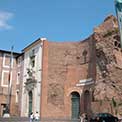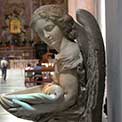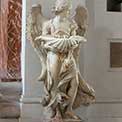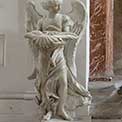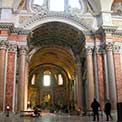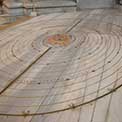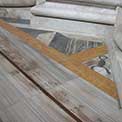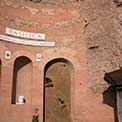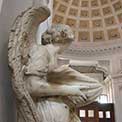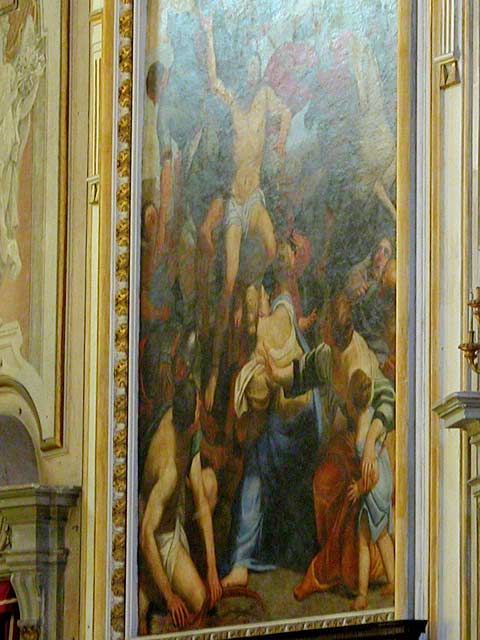
This magnificent church occupies the Pinacotheca, or, according to more recent opinions, the Cella Calidaria of the Thermas of Diocletian, which was altered by Michael Angelo, during the pontificate of Pius IV., to adapt it to Christian worship. It is one of the most imposing churches in Rome. The great hall of the baths was converted by Michael Angelo into a Greek cross by the addition of the present vestibule and of the tribune opposite. Vanvitelli reduced the church to its present form in 1740 by adapting the circular hall, or Laconicum, as an entrance, and lengthening the choir on the opposite side. The hall which Michael Angelo had preserved as a nave was thus converted into a transept; the chapels opening out of it, in the intervals of the columns, closed up; and the transepts lengthened by converting into the chapels of the Beato Nicolo Albergati, and of St Bruno, two halls of the baths. On account of the dampness of the ground Michael Angelo was obliged to raise the pavement about 8 feet, so that the original bases of the columns remain buried to that depth, which by the accumulation of the debris of the baths were considerably lower than the circumjacent soil. Of the sixteen Corinthian columns in the church, the eight in the transept only are antique, and of red Egyptian granite, with attached bases of white marble. The others, of brick covered with stucco and painted in scagliola, but so skilfully that it is fair to say that few could detect any difference between them and the genuine antiques, were added by Vanvitelli. In the circular vestibule are the tombs of Salvator Rosa, of Carlo Maratta, of Cardinal Parisio, professor of jurisprudence at Bologna, and of Cardinal Francesco Alciati, the learned chancellor of Rome under Pius IV. On the tomb of the last-named is the following pithy epitaph: " Virtute vixit; Memoria vivit; Gloria vivet." Salvator Rosa's tomb has an inscription which describes him as the "Pictorum sui temporis nulli secundum, poetarum omnium temporum principibus parem "; a friendly eulogy, which the judgment of posterity has not endorsed. On one side of the entrance to the great hall is the fine statue of St Bruno by the French sculptor Houdon.
Clement XIV. is said to have been a great admirer of this statue, remarking that " it would speak if the rule of his order did not prescribe silence." The hall, now forming the transept of the church, is 297 feet long by 91 wide, and its height is 84 feet; the length of the present nave from the entrance to the high altar is 336 feet. The monolithic granite columns are each 45 feet high and 16 feet in circumference. These dimensions will give some idea of the colossal proportions of this superb church. The ancient capitals, four Corinthian and four Composite, are of white marble, as is the entablature. Over the arch leading to the tribune is inscribed " Regina Angelorum "; and over the altar the following poor couplet: "Quod fuit idolum nunc templum est virginis: auctor Est Pius ipse pater; daemones, aufugite." In the north wall of the choir there is a grated aperture, through which may be seen a chapel full of relics. A meridian line crosses the church and shows that its orientation is to the north-east. It was traced by Bianchini and Mualdiin 1701.
Sta Maria degli Angeli contains several large and fine paintings which were once altar-pieces in St Peter's, where they have been replaced by copies in mosaic when the originals were transported to this church. The most celebrated amongst them is Domenichino's St Sebastian, on the right hand side of the high altar. It is 22 feet high, and being painted on the wall it was removed with consummate skill by the engineer Zabaglia.
Over against it is Carlo Maratta's Baptism of Our Lord, a fine work of that artist. The other paintings in the choir are the Presentation in the Temple, by Romanelli, and the Death of Ananias by Roncalli. In the transept are eight pictures by various artists, among them being a copy of Guido's Crucifixion of St Peter.
At each extremity of the transept are spacious chapels formed out of the halls of the baths; that on the right, and which formed the vestibule to Michael Angelo's church, is dedicated to the Beato Niccolo Albergati; and that on the left to St Bruno, over the altar of which is a painting of St Peter appearing to some Carthusian monks, by Odazzi, and on the sides two, by Trevisani, of the death of the Maccabees. Standing at the central point, where the lines of the nave and transept cross each other, the effect of the interior of Sta Maria degli Angeli is incomparably fine. The four radiating arms, which here meet and blend, leave the impression of simplicity and regularity, without a formal monotony, and typify the spirit of Christianity which binds together the four corners of the globe by the ties of a common love and a common faith.
Behind the church is the Carthusian convent, founded and endowed by the Orsini family, and enclosing Michael Angelo's celebrated cloister surrounded by a portico carried upon 100 Doric columns of travertine, forming four spacious walks. In the garth are the immense cypresses planted round the fountain by the architect when he built the cloister, and measuring 13 feet in circumference. The " Pope's oil-cellar," as it is called, adjoining the church, is a low-arched hall of the ancient thermae, containing several cisterns or reservoirs sunk deep in the ground, where the supply of oil for the city is preserved at an equable temperature. There are many other remains of the baths, all of extraordinary scale and magnificence.
The masonry is of thin tiles with broad joints, and the walls are full of discharging arches, which are often made with concentric arches of these tiles. The vaulting is, of course, Roman; the diagonals of one bay make a sinuous line if laid down in plan.
THE CATHEDRALS AND CHURCHES OF ROME AND SOUTHERN ITALY By T. Francis Bumpus.
LONDON - T. WERNER LAURIE - CLIFFORD'S INN

